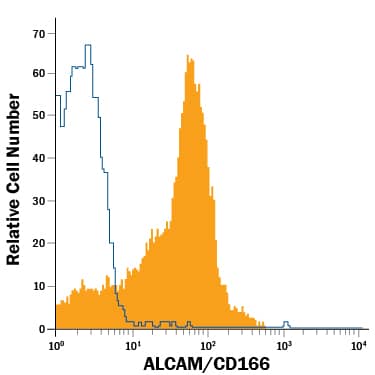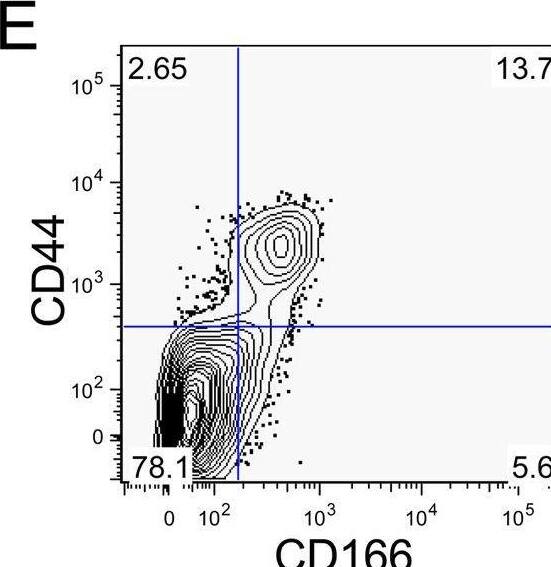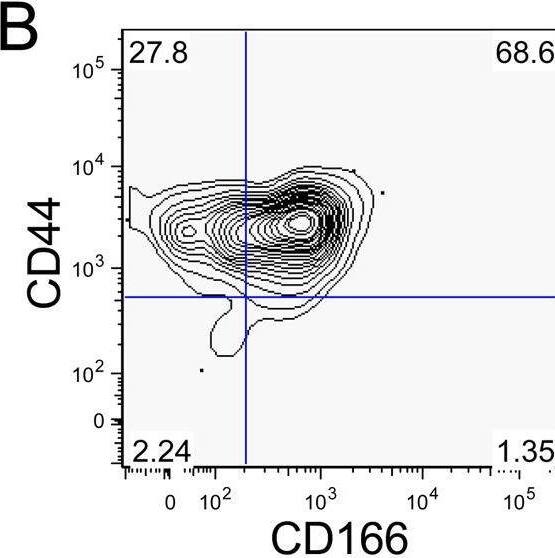Human ALCAM/CD166 PE-conjugated Antibody
R&D Systems, part of Bio-Techne | Catalog # FAB6561P


Key Product Details
Species Reactivity
Validated:
Cited:
Applications
Validated:
Cited:
Label
Antibody Source
Product Specifications
Immunogen
Trp28-Ala526
Accession # Q13740
Specificity
Clonality
Host
Isotype
Scientific Data Images for Human ALCAM/CD166 PE-conjugated Antibody
Detection of ALCAM/CD166 in Human Whole Blood Monocytes by Flow Cytometry.
Human whole blood monocytes were stained with Mouse Anti-Human ALCAM/CD166 PE-conjugated Monoclonal Antibody (Catalog # FAB6561P, filled histogram) or isotype control antibody (IC002P, open histogram). View our protocol for Staining Membrane-associated Proteins.Detection of Human ALCAM/CD166 by Flow Cytometry
Analysis of CSC marker expression in TOP-GFP cultures.(A) Representative images of the three independent single-cell-cloned CSC cultures, lentivirally transduced with TOP-GFP. Phase contrast (top) and fluorescence microscopy (bottom) for each of the cultures indicated. Bar = 90 µm. (B) Single parameter histograms for GFP intensity for each of the TOP-GFP single-cell-cloned CSC cultures with the TOP-GFPlow (10% lowest) and TOP-GFPhigh (10% highest) populations indicated. (C) Single parameter histograms for the indicated cell surface markers for each of the indicated cultures. Gray denotes TOP-GFPlow (10% lowest) and green denotes TOP-GFPhigh (10% highest) populations. (D) Density plots for CD29/CD24 and CD44/CD166 from TOP-GFPlow (gray) and TOP-GFPhigh (green) populations of each culture. Additional details for this experiment can be found at https://osf.io/tfy28/.Flow cytometry gating strategy.Representative density plots of gating strategy to assess cell surface markers from TOP-GFPlow and TOP-GFPhigh populations. Forward scatter area (FSC-A) and PerCP-Cy5.5 was used to gate on viable cells (PI negative cells), followed by forward verses side scatter area (FSC-A vs SSC-A) to identify cells of interest and exclude debris, which were then analyzed by FSC-A and forward scatter width (FSC-W), and then SSC-A and side scatter width (SSC-W) to exclude doublet cells. From the single-cell population, SSC and FITC were used to gate on the TOP-GFPlow (10% lowest) and TOP-GFPhigh (10% highest) populations. TOP-GFPlow and TOP-GFPhigh populations were then assessed for PE and APC to detect the fluorophores conjugated to antibodies against the cell surface markers analyzed in this study. Additional details for this experiment can be found at https://osf.io/tfy28/. Image collected and cropped by CiteAb from the following publication (https://pubmed.ncbi.nlm.nih.gov/31215867), licensed under a CC-BY license. Not internally tested by R&D Systems.Detection of Human ALCAM/CD166 by Flow Cytometry
Analysis of CSC marker expression in TOP-GFP cultures.(A) Representative images of the three independent single-cell-cloned CSC cultures, lentivirally transduced with TOP-GFP. Phase contrast (top) and fluorescence microscopy (bottom) for each of the cultures indicated. Bar = 90 µm. (B) Single parameter histograms for GFP intensity for each of the TOP-GFP single-cell-cloned CSC cultures with the TOP-GFPlow (10% lowest) and TOP-GFPhigh (10% highest) populations indicated. (C) Single parameter histograms for the indicated cell surface markers for each of the indicated cultures. Gray denotes TOP-GFPlow (10% lowest) and green denotes TOP-GFPhigh (10% highest) populations. (D) Density plots for CD29/CD24 and CD44/CD166 from TOP-GFPlow (gray) and TOP-GFPhigh (green) populations of each culture. Additional details for this experiment can be found at https://osf.io/tfy28/.Flow cytometry gating strategy.Representative density plots of gating strategy to assess cell surface markers from TOP-GFPlow and TOP-GFPhigh populations. Forward scatter area (FSC-A) and PerCP-Cy5.5 was used to gate on viable cells (PI negative cells), followed by forward verses side scatter area (FSC-A vs SSC-A) to identify cells of interest and exclude debris, which were then analyzed by FSC-A and forward scatter width (FSC-W), and then SSC-A and side scatter width (SSC-W) to exclude doublet cells. From the single-cell population, SSC and FITC were used to gate on the TOP-GFPlow (10% lowest) and TOP-GFPhigh (10% highest) populations. TOP-GFPlow and TOP-GFPhigh populations were then assessed for PE and APC to detect the fluorophores conjugated to antibodies against the cell surface markers analyzed in this study. Additional details for this experiment can be found at https://osf.io/tfy28/. Image collected and cropped by CiteAb from the following publication (https://pubmed.ncbi.nlm.nih.gov/31215867), licensed under a CC-BY license. Not internally tested by R&D Systems.Applications for Human ALCAM/CD166 PE-conjugated Antibody
Flow Cytometry
Sample: Human whole blood monocytes
Formulation, Preparation, and Storage
Purification
Formulation
Shipping
Stability & Storage
Background: ALCAM/CD166
ALCAM, activated leukocyte cell adhesion molecule, is a type I membrane glycoprotein and a member of the immunoglobulin supergene family. It is also known as CD166, MEMD, SC-1/DM-GRASP/BEN in the chicken, and KG-CAM in the rat. ALCAM is expressed on thymic epithelial cells, activated B and T cells, and monocytes. ALCAM can bind itself homotypically and is also capable of binding CD6, NgCAM, and other, as of yet, unidentified brain proteins. The ALCAM/CD6 interaction may be involved in T cell development and T cell regulation. Additionally, ALCAM/CD6 and ALCAM/NgCAM interactions may play roles in the nervous system. ALCAM has also been observed to be upregulated on highly metastasizing melanoma cell lines and may play a role in tumor migration. ALCAM is a 583 amino acid (aa) protein consisting of a 27 aa signal peptide, a 500 aa extracellular domain, a 24 aa transmembrane domain and a 32 aa cytoplasmic domain. The extracellular domain of ALCAM contains 5 Ig-like domains.
References
- Bowen, M.A. et al. (1995) J. Exp. Med. 181:2213.
- Aruffo, A. et al. (1997) Immunol. Today 18:498.
- Degen, W.G. et al. (1998) Am. J. Pathol. 152:805.
Long Name
Alternate Names
Gene Symbol
UniProt
Additional ALCAM/CD166 Products
Product Documents for Human ALCAM/CD166 PE-conjugated Antibody
Product Specific Notices for Human ALCAM/CD166 PE-conjugated Antibody
For research use only



